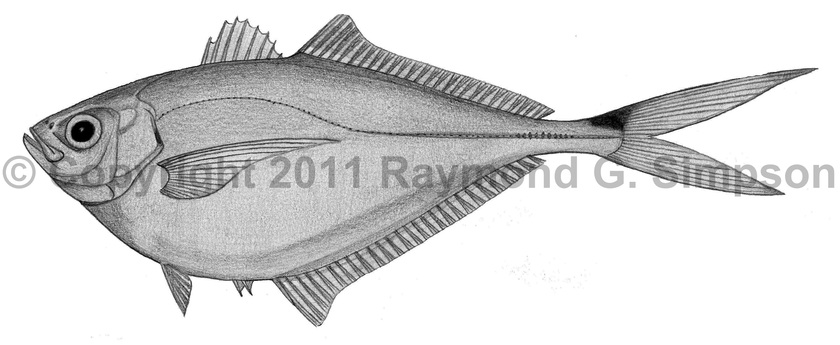
Common Name
Atlantic Bumper
Year Described
Linnaeus, 1766
Identification
Dorsal Fin: 8 spines in first lobe, followed by I, 25-28
Anal Fin: 2 spines separate from rest, followed by I, 25-28
Pelvic Fin: I, 5
Gill Rakers: 9-12 upper, 30-37 lower
Vertebrae: 10 precaudal, 16 caudal
Ovoid and very deep-bodied, with a small head, upturned mouth, and small eye (3.0-3.4 times in HL). Ventral profile strongly convex. Adipose eyelid weak. Jaw small; reaches anterior margin of eye. Teeth blunt, in narrow bands in both jaws (2 in lower). Pectoral fins falcate, longer than head. Spiny dorsal fin lower than lobe of second dorsal fin. Anterior lobe of second dorsal and anal fin slightly raised. Tail deeply forked, with the upper lobe up to 1.2 times longer than the lower. Lateral line with a strong anterior arch and a straight posterior portion with 6-12 weak scutes. Small cycloid scales on entire body, including chest. Caudal keels absent.
Color
Bright silvery on sides and belly, metallic blue to olive green above. A blackish spot on the upper opercular margin. A black saddle spot on the caudal peduncle. Dorsal, anal, pectoral, and caudal fins yellowish to dusky.
Size
Common to 20cm FL. Maximum size to 26cm FL.
Habitat
A shallow water species found in the surf zone, estuaries, and over sandy lagoons. Forms large schools.
Range
Massachusetts to Uruguay, including Bermuda and the Caribbean islands.
References
Smith-Vaniz, W.F. 2003. Carangidae (pp 1426-1468). In: Carpenter. 2003. The living marine resources of the Western Central Atlantic v. 3.